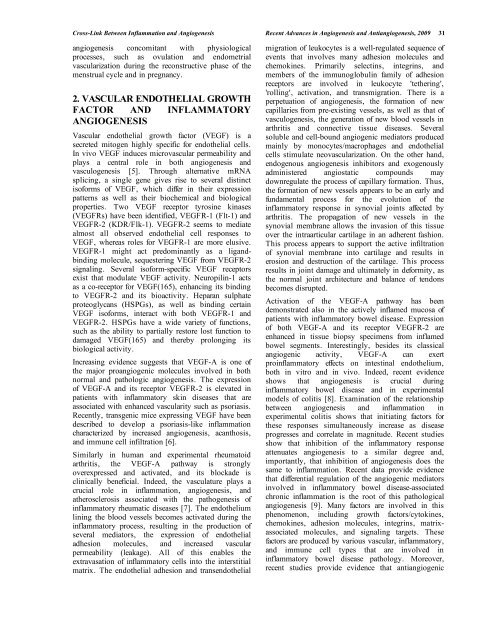Recent Advances in Angiogenesis and ... - Bentham Science
Recent Advances in Angiogenesis and ... - Bentham Science
Recent Advances in Angiogenesis and ... - Bentham Science
Create successful ePaper yourself
Turn your PDF publications into a flip-book with our unique Google optimized e-Paper software.
Cross-L<strong>in</strong>k Between Inflammation <strong>and</strong> <strong>Angiogenesis</strong> <strong>Recent</strong> <strong>Advances</strong> <strong>in</strong> <strong>Angiogenesis</strong> <strong>and</strong> Antiangiogenesis, 2009 31<br />
angiogenesis concomitant with physiological<br />
processes, such as ovulation <strong>and</strong> endometrial<br />
vascularization dur<strong>in</strong>g the reconstructive phase of the<br />
menstrual cycle <strong>and</strong> <strong>in</strong> pregnancy.<br />
2. VASCULAR ENDOTHELIAL GROWTH<br />
FACTOR AND INFLAMMATORY<br />
ANGIOGENESIS<br />
Vascular endothelial growth factor (VEGF) is a<br />
secreted mitogen highly specific for endothelial cells.<br />
In vivo VEGF <strong>in</strong>duces microvascular permeability <strong>and</strong><br />
plays a central role <strong>in</strong> both angiogenesis <strong>and</strong><br />
vasculogenesis [5]. Through alternative mRNA<br />
splic<strong>in</strong>g, a s<strong>in</strong>gle gene gives rise to several dist<strong>in</strong>ct<br />
isoforms of VEGF, which differ <strong>in</strong> their expression<br />
patterns as well as their biochemical <strong>and</strong> biological<br />
properties. Two VEGF receptor tyros<strong>in</strong>e k<strong>in</strong>ases<br />
(VEGFRs) have been identified, VEGFR-1 (Flt-1) <strong>and</strong><br />
VEGFR-2 (KDR/Flk-1). VEGFR-2 seems to mediate<br />
almost all observed endothelial cell responses to<br />
VEGF, whereas roles for VEGFR-1 are more elusive.<br />
VEGFR-1 might act predom<strong>in</strong>antly as a lig<strong>and</strong>b<strong>in</strong>d<strong>in</strong>g<br />
molecule, sequester<strong>in</strong>g VEGF from VEGFR-2<br />
signal<strong>in</strong>g. Several isoform-specific VEGF receptors<br />
exist that modulate VEGF activity. Neuropil<strong>in</strong>-1 acts<br />
as a co-receptor for VEGF(165), enhanc<strong>in</strong>g its b<strong>in</strong>d<strong>in</strong>g<br />
to VEGFR-2 <strong>and</strong> its bioactivity. Heparan sulphate<br />
proteoglycans (HSPGs), as well as b<strong>in</strong>d<strong>in</strong>g certa<strong>in</strong><br />
VEGF isoforms, <strong>in</strong>teract with both VEGFR-1 <strong>and</strong><br />
VEGFR-2. HSPGs have a wide variety of functions,<br />
such as the ability to partially restore lost function to<br />
damaged VEGF(165) <strong>and</strong> thereby prolong<strong>in</strong>g its<br />
biological activity.<br />
Increas<strong>in</strong>g evidence suggests that VEGF-A is one of<br />
the major proangiogenic molecules <strong>in</strong>volved <strong>in</strong> both<br />
normal <strong>and</strong> pathologic angiogenesis. The expression<br />
of VEGF-A <strong>and</strong> its receptor VEGFR-2 is elevated <strong>in</strong><br />
patients with <strong>in</strong>flammatory sk<strong>in</strong> diseases that are<br />
associated with enhanced vascularity such as psoriasis.<br />
<strong>Recent</strong>ly, transgenic mice express<strong>in</strong>g VEGF have been<br />
described to develop a psoriasis-like <strong>in</strong>flammation<br />
characterized by <strong>in</strong>creased angiogenesis, acanthosis,<br />
<strong>and</strong> immune cell <strong>in</strong>filtration [6].<br />
Similarly <strong>in</strong> human <strong>and</strong> experimental rheumatoid<br />
arthritis, the VEGF-A pathway is strongly<br />
overexpressed <strong>and</strong> activated, <strong>and</strong> its blockade is<br />
cl<strong>in</strong>ically beneficial. Indeed, the vasculature plays a<br />
crucial role <strong>in</strong> <strong>in</strong>flammation, angiogenesis, <strong>and</strong><br />
atherosclerosis associated with the pathogenesis of<br />
<strong>in</strong>flammatory rheumatic diseases [7]. The endothelium<br />
l<strong>in</strong><strong>in</strong>g the blood vessels becomes activated dur<strong>in</strong>g the<br />
<strong>in</strong>flammatory process, result<strong>in</strong>g <strong>in</strong> the production of<br />
several mediators, the expression of endothelial<br />
adhesion molecules, <strong>and</strong> <strong>in</strong>creased vascular<br />
permeability (leakage). All of this enables the<br />
extravasation of <strong>in</strong>flammatory cells <strong>in</strong>to the <strong>in</strong>terstitial<br />
matrix. The endothelial adhesion <strong>and</strong> transendothelial<br />
migration of leukocytes is a well-regulated sequence of<br />
events that <strong>in</strong>volves many adhesion molecules <strong>and</strong><br />
chemok<strong>in</strong>es. Primarily select<strong>in</strong>s, <strong>in</strong>tegr<strong>in</strong>s, <strong>and</strong><br />
members of the immunoglobul<strong>in</strong> family of adhesion<br />
receptors are <strong>in</strong>volved <strong>in</strong> leukocyte 'tether<strong>in</strong>g',<br />
'roll<strong>in</strong>g', activation, <strong>and</strong> transmigration. There is a<br />
perpetuation of angiogenesis, the formation of new<br />
capillaries from pre-exist<strong>in</strong>g vessels, as well as that of<br />
vasculogenesis, the generation of new blood vessels <strong>in</strong><br />
arthritis <strong>and</strong> connective tissue diseases. Several<br />
soluble <strong>and</strong> cell-bound angiogenic mediators produced<br />
ma<strong>in</strong>ly by monocytes/macrophages <strong>and</strong> endothelial<br />
cells stimulate neovascularization. On the other h<strong>and</strong>,<br />
endogenous angiogenesis <strong>in</strong>hibitors <strong>and</strong> exogenously<br />
adm<strong>in</strong>istered angiostatic compounds may<br />
downregulate the process of capillary formation. Thus,<br />
the formation of new vessels appears to be an early <strong>and</strong><br />
fundamental process for the evolution of the<br />
<strong>in</strong>flammatory response <strong>in</strong> synovial jo<strong>in</strong>ts affected by<br />
arthritis. The propagation of new vessels <strong>in</strong> the<br />
synovial membrane allows the <strong>in</strong>vasion of this tissue<br />
over the <strong>in</strong>traarticular cartilage <strong>in</strong> an adherent fashion.<br />
This process appears to support the active <strong>in</strong>filtration<br />
of synovial membrane <strong>in</strong>to cartilage <strong>and</strong> results <strong>in</strong><br />
erosion <strong>and</strong> destruction of the cartilage. This process<br />
results <strong>in</strong> jo<strong>in</strong>t damage <strong>and</strong> ultimately <strong>in</strong> deformity, as<br />
the normal jo<strong>in</strong>t architecture <strong>and</strong> balance of tendons<br />
becomes disrupted.<br />
Activation of the VEGF-A pathway has been<br />
demonstrated also <strong>in</strong> the actively <strong>in</strong>flamed mucosa of<br />
patients with <strong>in</strong>flammatory bowel disease. Expression<br />
of both VEGF-A <strong>and</strong> its receptor VEGFR-2 are<br />
enhanced <strong>in</strong> tissue biopsy specimens from <strong>in</strong>flamed<br />
bowel segments. Interest<strong>in</strong>gly, besides its classical<br />
angiogenic activity, VEGF-A can exert<br />
pro<strong>in</strong>flammatory effects on <strong>in</strong>test<strong>in</strong>al endothelium,<br />
both <strong>in</strong> vitro <strong>and</strong> <strong>in</strong> vivo. Indeed, recent evidence<br />
shows that angiogenesis is crucial dur<strong>in</strong>g<br />
<strong>in</strong>flammatory bowel disease <strong>and</strong> <strong>in</strong> experimental<br />
models of colitis [8]. Exam<strong>in</strong>ation of the relationship<br />
between angiogenesis <strong>and</strong> <strong>in</strong>flammation <strong>in</strong><br />
experimental colitis shows that <strong>in</strong>itiat<strong>in</strong>g factors for<br />
these responses simultaneously <strong>in</strong>crease as disease<br />
progresses <strong>and</strong> correlate <strong>in</strong> magnitude. <strong>Recent</strong> studies<br />
show that <strong>in</strong>hibition of the <strong>in</strong>flammatory response<br />
attenuates angiogenesis to a similar degree <strong>and</strong>,<br />
importantly, that <strong>in</strong>hibition of angiogenesis does the<br />
same to <strong>in</strong>flammation. <strong>Recent</strong> data provide evidence<br />
that differential regulation of the angiogenic mediators<br />
<strong>in</strong>volved <strong>in</strong> <strong>in</strong>flammatory bowel disease-associated<br />
chronic <strong>in</strong>flammation is the root of this pathological<br />
angiogenesis [9]. Many factors are <strong>in</strong>volved <strong>in</strong> this<br />
phenomenon, <strong>in</strong>clud<strong>in</strong>g growth factors/cytok<strong>in</strong>es,<br />
chemok<strong>in</strong>es, adhesion molecules, <strong>in</strong>tegr<strong>in</strong>s, matrixassociated<br />
molecules, <strong>and</strong> signal<strong>in</strong>g targets. These<br />
factors are produced by various vascular, <strong>in</strong>flammatory,<br />
<strong>and</strong> immune cell types that are <strong>in</strong>volved <strong>in</strong><br />
<strong>in</strong>flammatory bowel disease pathology. Moreover,<br />
recent studies provide evidence that antiangiogenic

















